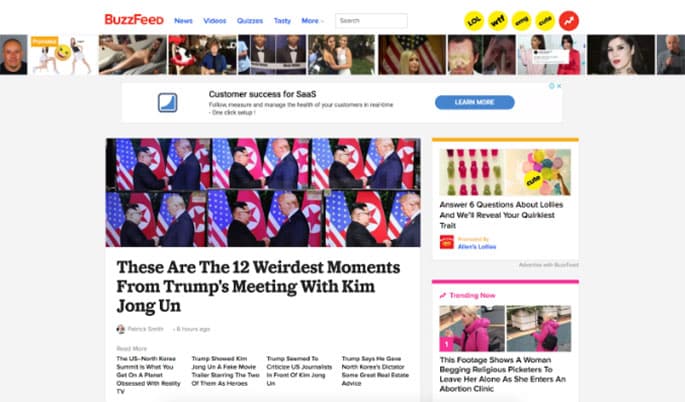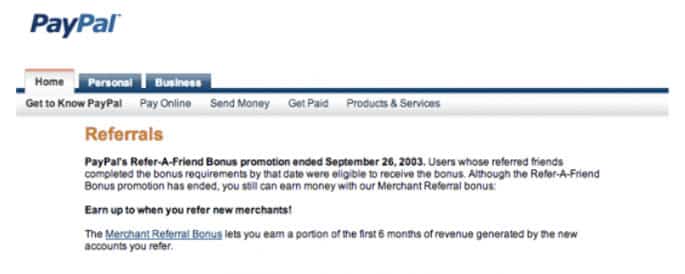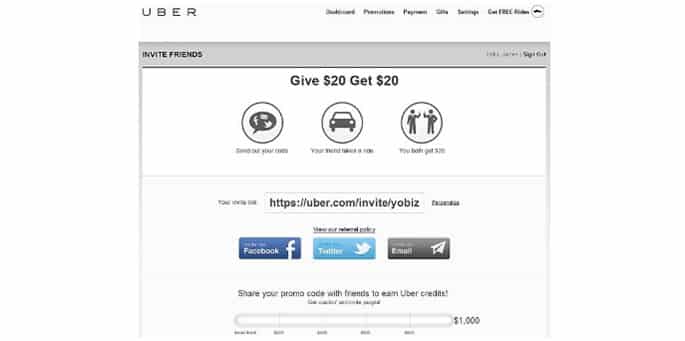Growth-hacker marketing is not a set of best practices, but a mindset. Below I describe 24 inspiring cases that illustrate the many shapes digital growth hacking can take.
As Ryan Holiday writes in his excellent little book Growth Hacker Marketing:
“Traditional marketing strategies simply weren’t used to build companies like Facebook, Airbnb, and Twitter, and they’re some of the fastest growing companies in the world.”
24 Growth Hacking Examples: From Airbnb to Zappos
Their tremendous successes were made possible by a new approach: growth-hacking marketing. It is not a set of tools or best practices, but a mindset, an approach. The following case studies illustrate the many shapes growth-hacking marketing can take. I limited myself to examples with a digital component, because that is my field of expertise.
Airbnb
Airbnb struggled to find people to use their platform which enabled people to lease or rent short-term lodging. So, the San Francisco company chose to target the audience of Craigslist.
By providing an option for homeowners to automatically post to Craigslist, Airbnb reached more potential users. Today, Airbnb has over 12 million rental locations and over 100 million users worldwide.

Amazon.com
Amazon.com stores the search behavior of customers on its website and uses data to make them a tailor-made offer through email. There are 2 types of recommendation emails that the American online shop sends out.
The first is when a customer has viewed a particular product many times but not made a purchase. The second one is a list of products that are related to their browsing patterns. This personalized approach is one of the causes Amazon became the biggest bookseller in the world.
Booking.com
Customers are more interested in products that are scarce or at least seem to be. Booking.com is a master of this kind of persuasion.
The platform serves notifications such as “There are 13 people looking at this hotel”. And: “Most recent booking for this property was 14 minutes ago from the United Kingdom.” These messages create a sense of urgency in the customer resulting in much higher conversion rates.
Buffer
This app was developed to help people manage and schedule their social media posts. How did they acquire around 100,000 users within the first 9 months? The unexpected answer: through guest blogging on other websites.
Within the space of around 9 months, Buffer co-founder Leo Widrich wrote around 150 guest posts.
“Of course the early ones barely drove any traffic, and only very gradually did things improve. I think that’s very important to understand. It will take a while until you can find the right frequency of posting,” Widrich explained.
Buzzfeed
The news site Buzzfeed is the poster boy of click-bait. But, there is more to it than just celebrity gossip and nice, pet pictures. Buzzfeed A/B tests pretty much everything. The website shows multiple versions of articles to website visitors, not just the headline or the thumbnail that’s rendered on Facebook or Twitter, etc.

After a couple of hours, the website visitors’ clicks decide the winning combination of copy, image, and headline. It really works. Buzzfeed ranks in the top 100 of US websites, many articles going viral.
Dropbox
Dropbox tried Google AdWords in the early days. But the cost to acquire new customers was higher than the average customer lifetime value. Then, the cloud-based service for file storage introduced an easy-to-use referral program: invite your friends and get extra storage space.
This approach was cheaper than ads and proved very effective. In a 15-month period, the company went from having 100,000 users to having 4 million users.
Gmail
When Google launched Gmail in 2004, it was accessible by invitation only. By making the product scarcer and more exclusive, people became more interested in the service. This is in line with Dr. Robert Cialdini’s research on persuasion. It worked: Gmail has 1.2 billion users today.
Hotmail
Free email service Hotmail grew rapidly by one single trick. Starting in 1996, each email message had the following signature at the bottom: “Get your free email at Hotmail,” with a link to the Hotmail homepage. Within 18 months, 60% of internet users had a Hotmail account.

HubSpot
HubSpot had extensive, but costly features, so their challenge was to find users for their platform. The trick was a “lock-in” strategy. The CRM product became 100% free, and for smaller companies, there was a 90% discount. A lot of businesses found this an appealing proposal.
Consequently, all their contacts, landing pages, analytics, and so on were “locked-in” in HubSpot. Migrating to another solution was almost impossible. This way, HubSpot became one of the most popular, all-in-one marketing platforms on the web.
In 2009, 27-year-old Stanford University graduate Kevin Systrom built Burbn, a location-based, social network. The app was well received, but attracting new users was much harder.
Looking into the user data, Systrom found out Burbn was mostly used for sharing photography. So, the app was stripped of most of its extraneous features and was renamed Instagram. Today, Instagram competes with SnapChat as the leading social network for teens.
Netflix
Executives at Netflix knew director David Fincher’s TV series House of Cards would be a hit. Of course, the viewing public’s preferences are fickle, so in showbiz, nothing is really certain. But Netflix had dived deep into its data.
For example, they knew that many customers had streamed Fincher’s movies from beginning to end. Moreover, the British version of House of Cards had also performed well on Netflix as had films featuring Kevin Spacey. The Netflix executives had analyzed the data wisely. House of Cards became a hit series and their biggest showpiece.
OkCupid
In 2007, OkCupid integrated with Facebook. This dating site enabled its users to participate in quizzes and linked the interactions to their personality type and profile. Facebook’s massive reach worked miracles. The users of OkCupid grew from 600,000 active users in 2007 to 1 million now.
Paddy Power
Prior to the 2014 FIFA World Cup, Irish bookmaker Paddy Power posted a photo on its Twitter account, allegedly showing an overhead view of a Brazilian rainforest with the message “C’MON ENGLAND PP” spelled out by the former locations of trees that had been cut down.
Following major criticisms over the advert from users, it was revealed that the images were fake and actually part of a campaign by Paddy Power to promote its anti-deforestation charity effort.
PayPal
In 2000, online payment solution PayPal tried to figure out the lowest cost per acquisition of a new member. The solution was an invite-a-friend email campaign; people would get paid real dollars when their invited friends joined PayPal. PayPal’s user base grew from 1 million to over 5 million within the space of around 5 months.

Shazam
Shazam is a mobile app that helps users identify songs. They encouraged users to hold their smartphones above their head and near the speakers because the software would function better this way. But this also raised questions from bystanders about what the user was doing.
A brilliant kind of digital marketing in the real world! Today, there are over 1 billion Shazam app downloads.
Spotify
Spotify was looking for tactics to increase its user base. To accomplish this, the online streaming service created a Facebook integration in 2011. It allowed users to post the tracks that they’re listening to on Facebook. As a result, Spotify was placed in front of everyone on Facebook, and its user base grew exponentially.
Tinder
Dating app Tinder is among the first “swiping apps,” whose users employ a swiping motion to choose pictures of other users, swiping right for potentially good matches and swiping left on a photo to move to the next one.
The secret of its success: the swiping movement transformed dating into an online game. after being launched in 2012, Tinder was registering about one billion “swipes” per day 2 years later.
Trendiy
Trendiy designs, manufactures, and sells window-decoration products to end users via the larger DIY (Do-It-Yourself) retail chains. The company was facing severe price pressure from its key clients, the DIY retailers.
RevelX researched the buying structure at the DIY retailers and the criteria for success of the buyers. They found out that the financial performance of shop space was of greater importance than product design, brand, and other factors.
Financial performance was largely influenced by logistic processes. The new value proposition addressed this logistic performance much more prominently than competitors did.
TripAdvisor
Hotel recommendation and review site TripAdvisor wanted to outsmart the competition by being on top of the Search Engine Optimization (SEO) game. Their growth hack was to ask hotels and restaurants to display TripAdvisor badges on their websites and offline in their venues.
By doing so, visitors to their websites and venues were made aware that they could review the venue on TripAdvisor resulting in more relevant content and thus in better findability.
Uber
Founded in 2009, taxi platform Uber‘s base in San Francisco was the key to its initial success. Here, the ridesharing network company organized events for the tech community. More important, they offered free rides to those attending.

News of Uber was spread word-of-mouth among early adopters of technology and worked miracles. Now, Uber serves 633 cities the world over. The revenue for 2017 was €7.5 billion.
WP Engine
WP Engine is a provider of hosting and optimization for WordPress blogs. Their referral program is very generous: $200 per new customer or 100% of the customer’s first monthly payment (whichever is higher). This trade-off seems expensive, but it has been cost-effective in finding valuable, paying customers.
YouTube
YouTube wanted to make their platform the number 1 go-to solution when it comes to video sharing. The solution was to make sharing frictionless.
YouTube made it very easy to post videos on any website with an easily adjustable frame, making it possible to “embed” videos by simply pasting a code into your own website or blog. With the launch of this function, YouTube exponentially grew its reach via millions of other websites creating an enormous awareness for their brand as a video sharing solution.
Zappos
Online shoe store Zappos is famous for its excellent customer service. Take for instance their 365-day return policy, and free, two-way shipping. The policy can be looked upon as a little bit too lenient, but in fact, it is a growth hack. Some customers may have returned half of their orders, but they are also the ones that spend the most money with Zappos and are their most profitable customers.
Björn Brekel
Lead growth hacker @ RevelX
Bringing startup thinking to the boardroom
Road cycling, minimalism and blockchain enthusiast
Related posts
5 Growth Mindset Examples That You Can Use in Your Job Tomorrow
People who believe their success is based on hard work,…
September 15, 2022
Retention strategy: Keeping the right customers
Retaining customers is a top-line priority for any…
May 15, 2020
Who are my most valuable customers?
Legend has it Alfredo Pareto noticed something unusual in…
April 22, 2020


